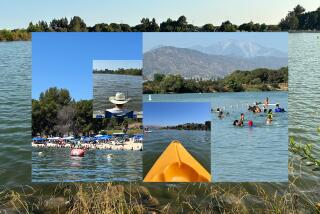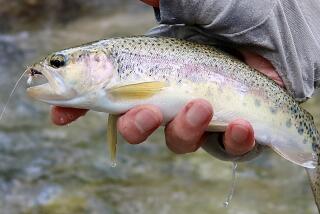Most Gnatcatchers Lack Refuge, County Says : Environment: Both sides cheer some of a public study’s findings. Just 10% of the located songbirds are protected in parks.
- Share via
SANTA ANA — About 10% of the gnatcatchers living in Orange County, 31 pairs, were found in county parks, which means that the majority of the birds are probably on unprotected, privately owned land, according to a new study commissioned by county officials.
Southern California builders have argued that the California gnatcatcher does not warrant protection as an endangered species because land dedicated to the county by the Irvine Co. and other major developers contains large, prime areas of habitat.
But the county study released Wednesday shows that most of the 27,000 acres in 14 regional parks have low or moderate potential for the birds, because the varieties of plants are unsuitable or the slopes are too steep.
A general summary of the research was released Monday, but no details were available until Wednesday.
“We found that we have gnatcatcher habitat that’s good to high quality, but there’s not an awful lot of it,” said Thomas B. Mathews, director of planning for the county Environmental Management Agency, which hired consultants to conduct the study.
The study was released a day before state officials hold a public hearing to consider nominating the songbird to the state endangered species list.
The California Fish and Game Commission meets at 8:30 a.m. today at Newport Harbor High School in Newport Beach. Commissioners could issue a ruling or delay a decision on the gnatcatcher.
If the panel names the songbird a candidate for the endangered list, its habitat--a mix of coastal sage scrub found in Orange, Riverside and San Diego counties--will immediately be protected for 12 months while a full review is conducted.
The study was commissioned because Orange County is one of the major landowners within its own boundaries, so county officials wanted a better understanding of where gnatcatchers nest in parks.
About half of the bird’s habitat is in San Diego County, mostly on private land, biologists say.
Mathews said he believes that the new study does not support all the contentions of either the environmentalists or the builders, so the County Board of Supervisors will make no recommendation to the state commission today.
He added that much more research will take place late this year and next year.
Both sides said they will use the county study to support their arguments today. Environmentalists say the report proves that further development will clear coastal sage scrub habitat on private property and help push the bird toward extinction.
“It directly undermines the often-repeated contention of the property owners that the land that has been set aside provides an adequate habitat for the gnatcatcher,” said Joel R. Reynolds, a senior attorney with the Natural Resources Defense Council.
“It shows that further loss of the habitat without the protections of listing will further endanger the species,” he said. “That’s why we need listing now.”
Builders, however, say the study shows that all 14 parks have some potential, and some gnatcatchers were found at nearly all of them.
Hugh Hewitt, an Irvine attorney representing the Building Industry Assn. of Southern California, said about the environmentalists: “Their entire petition depends on showing that all gnatcatchers will be wiped out. We now have concrete evidence that in some of Orange County’s open space that gnatcatchers are doing well. . . . This validates our own suggestion of the importance of the preserved open space.”
Thirty-one pairs of gnatcatchers, and a few single males or juveniles, were seen in the 14 parks during May and June surveys by biologist David Bontrager and two other researchers, according to the county report.
By comparison, a separate study conducted by Bontrager in 1989 showed that more than twice as many pairs--63--were seen on one small stretch of land owned by the Santa Margarita Co., the county’s second-largest development company.
Complete studies are not available on how many gnatcatchers exist on private land, but environmental documents for developments proposed by the Irvine Co. and Santa Margarita Co. show that much of their land contains the birds.
The 63 pairs were seen by Bontrager on a narrow, 5-milestretch of land earmarked for the proposed southern end of the Foothill Transportation Corridor tollway.
In all, the county has 240 to 298 pairs, according to Jonathan Atwood, a biologist who petitioned the state to declare the bird an endangered species. A report commissioned by the builder group estimates the countywide total at 325 to 350 pairs.
Twelve of the 14 parks have some areas of coastal sage scrub that has high potential for the birds, but “for the most part, (they) represent small portions,” says the county-commissioned study by Ed Almanza & Associates, an environmental consulting firm.
The 14 sites have limited use by the birds because of “the preponderance of steep slopes and, in some cases, elevations at the upper limits of the gnatcatcher’s range,” it says.
One key finding was that Irvine Coast Wilderness Park--the 900-acre park created by the Irvine Co. to compensate for new coastal development--contained no gnatcatchers and very little suitable habitat because of its steep slopes.
Laguna Laurel park, a 2,200-acre area that the county and Laguna Beach recently bought from the Irvine Co., has the most potential for gnatcatchers, with seven pairs and a single juvenile seen there during the surveys.
The study pointed out, however, that the proposed San Joaquin Hills Transportation Corridor tollway would cut the park in half and directly affect two areas where the birds were seen.
The consultants wrote that their mapping “erred on the conservative side, that is, overestimating the suitability of the habitat.”
The surveys were conducted in late spring, when it is more difficult to find the birds than in winter, when they nest.
Gnatcatchers in County Parks
In surveys conducted this summer of 14 large county parks, biologists found 31 pairs of gnatcatchers and a few single juveniles or males.
Location & Sitings
Foothill/Trabuco area: 1 pair and one juvenile
O’Neill Regional Park: 2 pairs
Wagon Wheel Regional Park: 7 pairs
Santiago Oaks Regional Park: 4 pairs
Carbon Canyon Regional Park: None
Caspers Regional Park: 2 pairs and one male
Irvine Regional Park: None
Laguna Laurel Wilderness Park: 7 pairs and one juvenile
Irvine Coast Regional Park: None
William R. Mason Regional Park: 2 pairs
Salt Creek Regional Park: 4 pairs
Whiting Ranch Regional Park: None
Upper Newport Bay Regional Park: None
Aliso/Wood Canyons Regional Park: 2 pairs and one male
Source: Orange County, Environmental Management Agency, report by Ed Almanza & Associates
More to Read
Sign up for Essential California
The most important California stories and recommendations in your inbox every morning.
You may occasionally receive promotional content from the Los Angeles Times.










